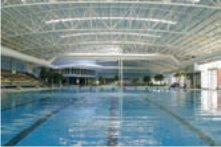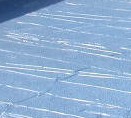If you are renovating or installing a new PVC lined indoor pool, consider the type of PVC liner you are using.
Some people say all liners are the same, with the only difference being thickness, but that’s just not true. Most liners are made from a PVC film. This flexible, stretch fabric relies on the structure of the pool, and the weight of the water to maintain its shape. This works well in most situations, and with high quality options available, it’s an excellent surface finish for both above ground and inground swimming pools that are outdoor.
However, under certain environmental conditions (likely to be found in an indoor pool) the fabric of a standard PVC liner can sometimes start to ‘absorb’ water.
PH, total chlorine levels, ventilation and bathing load are all thought to be contributing factors. If the liner fabric begins to absorb water, it eventually expands the PVC, which then causes wrinkles to form in the pool. The wrinkles usually start on the floor of the pool, but can be all over the whole liner. If you look closely at a section of affected PVC, you can see the surface is weakened, and prone to forming tiny cracks that can develop into larger tears.
If this happens, there is no reversing of the process, and the life span of the liner is greatly reduced.
While many indoor pools are surfaced with standard PVC liners without any problems, there is always a risk of it occurring in the right (or wrong) conditions, and it is best to avoid the risk completely in indoor pools, by using a reinforced liner.
AquaForce is a specialist reinforced PVC fabric which is suitable for use in indoor pools. AquaForce features an internal reinforcing layer that keeps the fabric stable in indoor pools, and virtually eliminates the risk of wrinkling.
With a three layer design, AquaForce has a PVC base ply, a layer of reinforced polyester mesh, then topped with another ply of PVC. All three layers are homogeneously bonded together during the manufacturing process to be permanently fused. The mesh reinforcing layer stabilises the fabric and stops it from shrinking or expanding.
Traditional PVC liners can be delivered to site fully welded in one piece, but AquaForce reinforced PVC liners are always fabricated on site, as they do not stretch or form to the pool shape.
The rolls of the AquaForce fabric are laid in the pool and overlapped to form seams that are welded on site. Edges are then sealed, to stop water absorption through the fabric itself. AquaForce liners can be fitted to any pool shape, as the liner is cut and shaped in the pool on site, allowing it to be fitted over steps and benches and down into deep ends of all style of pools.
So if you are looking to install a PVC liner in an indoor pool, we recommend the use of a reinforced PVC such as AquaForce, to reduce the risk of wrinkling. AquaForce is also recommended for use on Commercial Pools .
.
